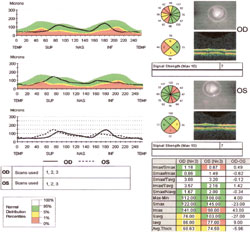Study: Spectral, time domain OCT data not interchangeable
A study comparing measurements taken by time domain and spectral domain optical coherence tomography technologies found that though they were highly correlated, the two were not interchangeable for following patients over time. This means when clinicians switch to a new instrument they must establish a new baseline, the researchers said.
The study
Retinal nerve fiber layer measurements were taken using the Stratus OCT (Carl Zeiss Meditec, Dublin, Calif.) and the Nerve Head Map on the RTVue (Optovue, Fremont, Calif.) on 17 eyes of 11 patients with early glaucoma and 28 eyes of 15 healthy patients. The thickness measurements and visual field indices for both groups were calculated and compared, the study authors said.
Study results showed significant differences in the two sets of retinal nerve fiber layer measurements. Average measurements from the RTVue were thicker than the Stratus measurements. Of all variables, the strongest correlation between the two instruments was in average thickness and the inferior quadrant.
  Figures 1 and 2. A
comparison of RTVue and Stratus printouts for the same glaucoma patient.
Images: Fingeret M |
|
“Of the measurements where the thickness and visual field indices had significant correlations, the RTVue performed as well (inferior quadrant) as the Stratus (average thickness),” the study authors said. “There were areas with weak to no correlation between thickness and visual field indices, which is likely due to known discrepancies in the relationship between structure and function in this population.”
Spectral vs. time domain
Primary Care Optometry News Editorial Board member Murray Fingeret, OD, an investigator for the study, said that the purpose of the comparison was to determine how well the instruments correlated, not to determine which technology was better than the other.
“We looked at the correlations and how they differed,” he told PCON. “If you’re following someone with one instrument and then you purchase a new instrument to replace it, can you simply carry on with that newer instrument where you left off with the older instrument? The answer is no, you cannot.
“Spectral domain is a faster technology that can capture more measuring points, which infers that the digital images have better resolution,” Dr. Fingeret continued. The registration feature allows for better recognition of loss or change over time, a crucial component necessary when following patients, he said.
Although time domain OCT is a valuable and worthy technology, it is almost 10 years old and does not have the features that spectral domain OCT boasts, Dr. Fingeret said.
“The time domain is very good — even now — for looking at nerve fiber layer thickness and macular thickness,” he said. “It’s a very good technology, but the evolution of instrumentation makes one appear to be a little bit better.”
Start from scratch
Clinicians use OCT technology for two reasons: first, to help make a diagnosis and, second, to follow the patient over time and watch for change, Dr. Fingeret said. Even new OCT machines from the same company are not “backwards compatible,” he said, which makes following a patient over time nearly impossible.
“What we’re showing is that even if you’re between instruments or are switching to different companies, these things are just plain and simple not the same,” he said. “When you get a new instrument, it’s as if all of the data you’ve had from your older instrument is lost, in terms of following over time. The clinician really has to start from scratch.”
For more information:
- Murray Fingeret, OD, is chief of the optometry section at the Department of Veterans’ Affairs Medical Center in Brooklyn and Saint Albans, N.Y., and a professor at SUNY College of Optometry. He is also a member of the Primary Care Optometry News Editorial Board. He may be contacted at St. Albans VA Hospital, Linden Blvd. and 179th St., St. Albans, NY 11425; (718) 298-8498; fax: (516) 569-3566; e-mail: murrayf@optonline.net. Dr. Fingeret is a paid consultant to Carl Zeiss Meditec.
Reference:
- Sloane A, Klein R, Fingeret M. A comparison between spectral domain and time domain OCT in glaucoma: A pilot study. Paper presented at: American Academy of Optometry Annual Meeting; November 11, 2009; Orlando, Fla.
